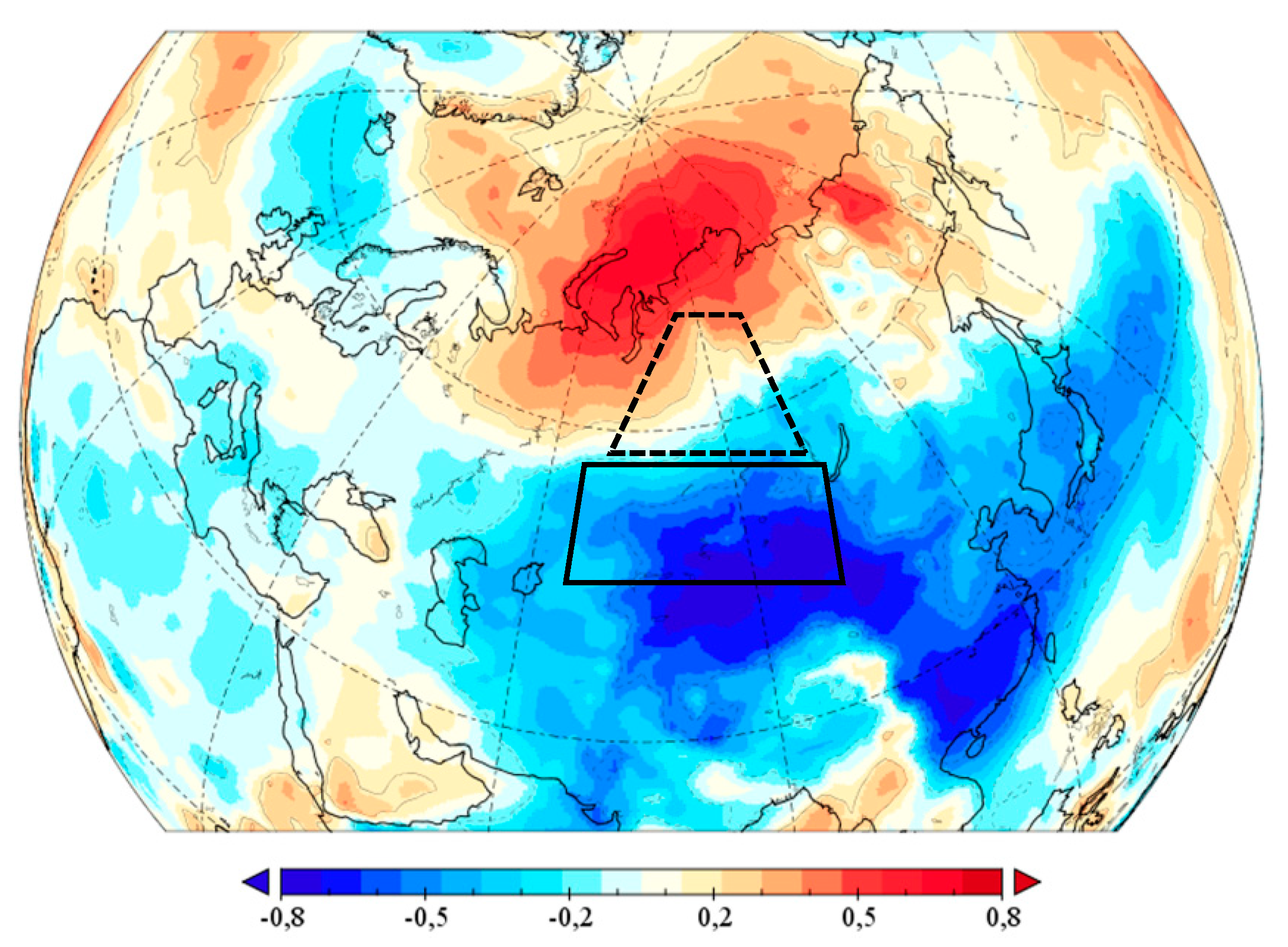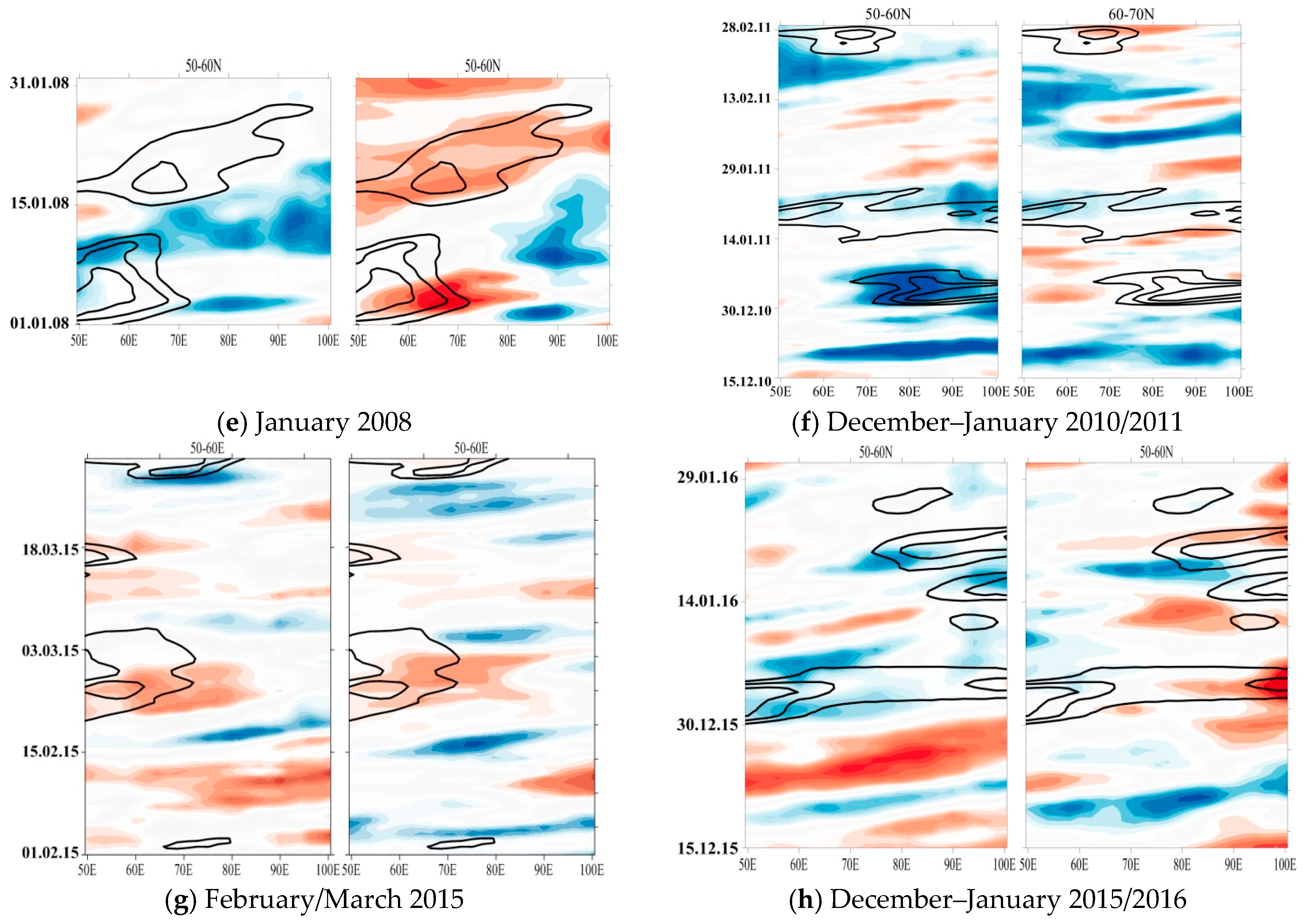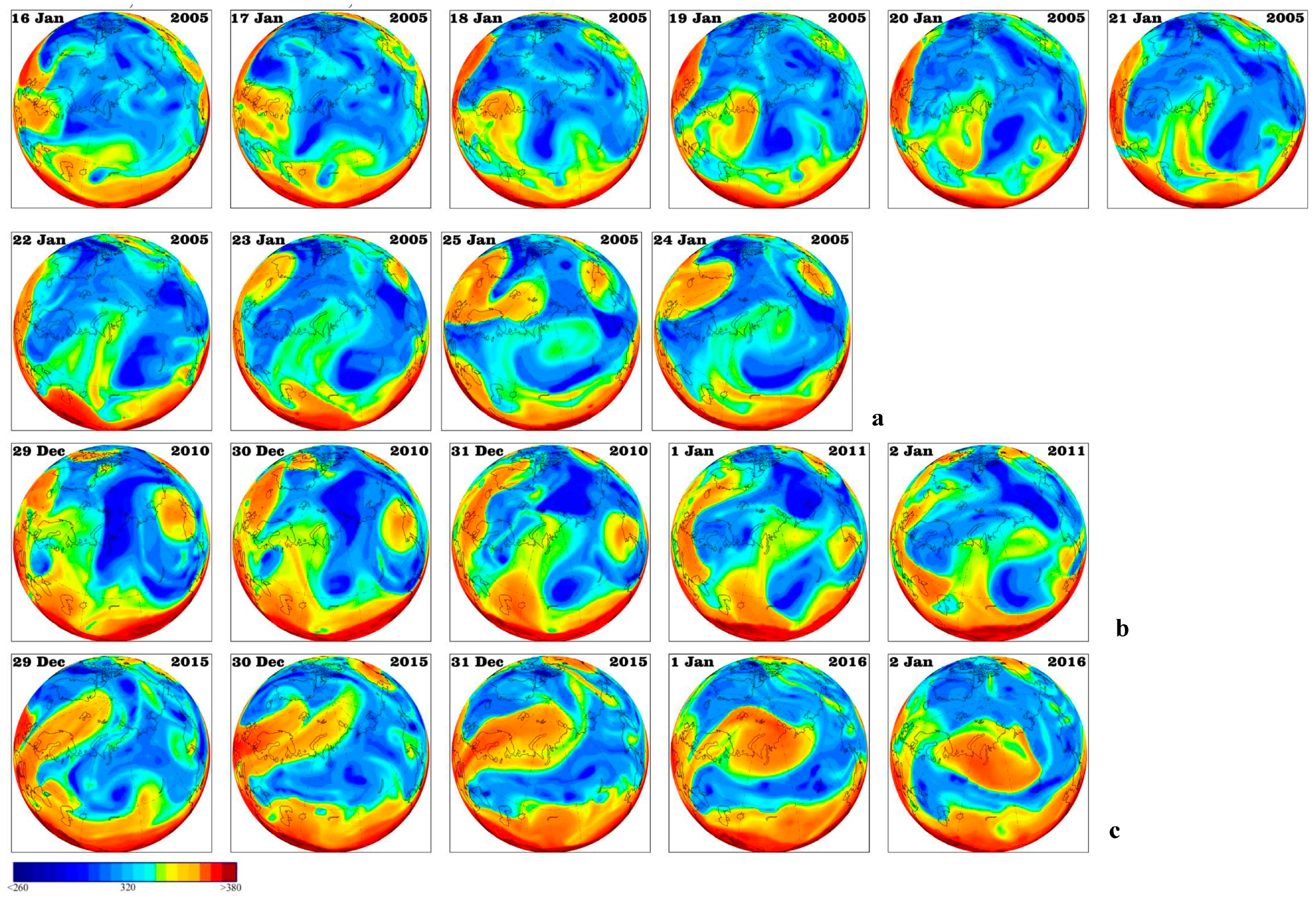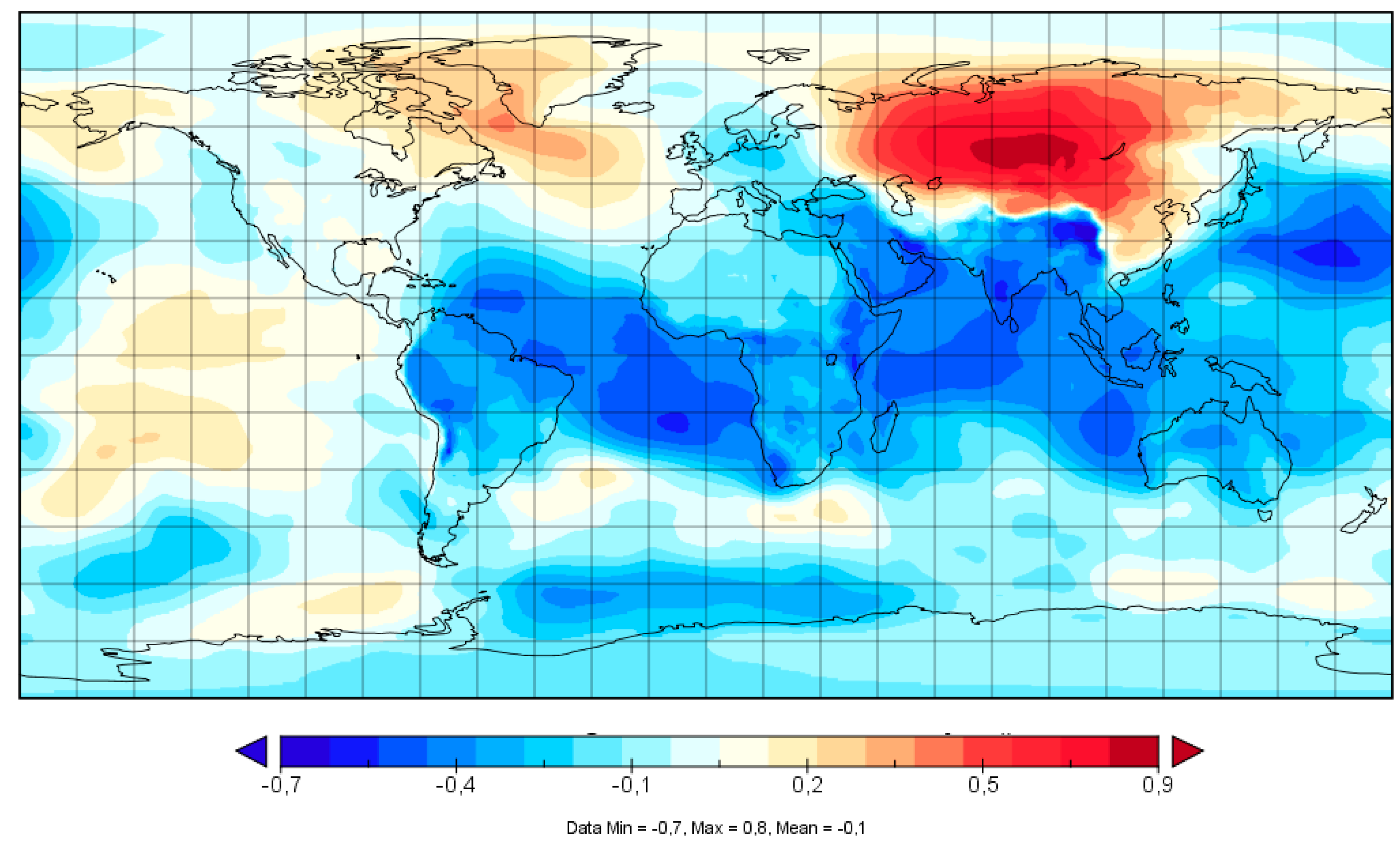Wintertime Atmospheric Blocking Events over Western Siberia in the Period 2004–2016 and Their Influence on the Surface Temperature Anomalies †
Abstract
:1. Introduction
2. Experiments
- We used ECMWF ERA Interim data (geopotential, surface temperature, potential temperature on the dynamical tropopause (PV-θ), sea level pressure) [8].
- To determine blocking events we applied criterion proposed by Tibaldi and Molteni [9]. We investigated blocking events with duration of 5 days or more in wintertime (1 November–31 March).where Z—geopotential height 500 gPa, φn = 80° N ± Δ, φ0 = 60° N ± Δ, φs = 40° N ± Δ, Δ = 4°.
- We chose 15 blockings events: December 2004, January–February 2005, December 2005, November 2006, January 2008 (two events), December 2008, December–January 2010–2011, January 2011, February 2011, December 2011, January–February 2012, December 2012, February–March 2015, December 2015–January 2016. So, we studied 12 winters. Only 2 winters has no blocking events (2009/2010 and 2013/2014). 4 winters are distinguished by high blocking frequency 2004/2005 (2 events), 2007/2008 (2), 2010/2011 (3), 2011/2012 (2). 6 winters have one event each.
- For each event we calculate surface temperature anomaly in the grid points for two sectors 60–90 E; 50–60 N (southern part of West Siberia) and 60–90 E; 60–70 N (northern part of West Siberia). Anomalies were calculated as deviation of daily surface temperature values from 1979–2015 mean. We chose sectors based on the result of the work [1], in which the correlation pattern between West Siberian blocking events and surface temperature was demonstrated (Figure 1). This pattern shows that Western Siberia is divided into two parts: the northern, over which there is positive blocking’s influence on the surface temperature and the southern, over which there is negative blocking’s influence on the surface temperature.
- To estimate advective transfer we analyzed the potential temperature on the dynamical tropopause (PV-θ) [3] for each of studied 15 events.
3. Results
4. Conclusions
Acknowledgments
Conflicts of Interest
References
- Antokhina, O.Y.; Antokhin, P.N.; Devyatova, E.V.; Martynova, Y.V. Atmospheric blocking in Western Siberia. Part II: Long-term variations and the connection with climate variability in Asia. Russ. Meteorol. Hydrol. 2018; in press. [Google Scholar]
- Mokhov, I.I.; Timazhev, A.V.; Lupo, A.R. Changes in atmospheric blocking characteristics within Euro-Atlantic region and Northern Hemisphere as a whole in the 21st century from model simulations using RCP anthropogenic scenarios. Glob. Planet. Chang. 2014, 122, 265–270. [Google Scholar] [CrossRef]
- Pelly, J.L.; Hoskins, B.J. A new perspective on blocking. J. Atmos. Sci. 2003, 60, 743–755. [Google Scholar] [CrossRef]
- Rex, D.F. Blocking action in the middle troposphere and its effect upon regional climate. I. An aerological study of blocking action. Tellus 1950, 2, 196–211. [Google Scholar]
- Cheung, H.N.; Zhou, W.; Mok, H.Y.; Wu, M.C.; Shao, Y. Revisiting the climatology of atmospheric blocking in the Northern Hemisphere. Adv. Atmos. Sci. 2013, 30, 397–410. [Google Scholar] [CrossRef]
- Cheung, H.N.; Zhou, W.; Shao, Y.; Chen, W.; Mok, H.Y.; Wu, M.C. Observational climatology and characteristics of wintertime atmospheric blocking over Ural–Siberia. Clim. Dyn. 2012, 41, 63–79. [Google Scholar] [CrossRef]
- Mokhov, I.I.; Semenov, V.A. Weather and Climate Anomalies in Russian Regions Related to Global Climate Change. Russ. Meteorol. Hydrol. 2016, 41, 84–92. [Google Scholar] [CrossRef]
- Dee, D.P.; Uppala, S.M.; Simmons, A.J.; Berrisford, P.; Poli, P.; Kobayashi, S.; Andrae, U.; Balmaseda, M.A.; Balsamo, G.; Bauer, P.; et al. The ERA-Interim reanalysis: Configuration and performance of the data assimilation system. Q. J. R. Meteorol. Soc. 2011, 137, 553–597. [Google Scholar] [CrossRef]
- Tibaldi, S.; Molteni, F. On the operational predictability of blocking. Tellus 1990, 42, 343–365. [Google Scholar] [CrossRef]





Publisher’s Note: MDPI stays neutral with regard to jurisdictional claims in published maps and institutional affiliations. |
© 2017 by the authors. Licensee MDPI, Basel, Switzerland. This article is an open access article distributed under the terms and conditions of the Creative Commons Attribution (CC BY) license (https://creativecommons.org/licenses/by/4.0/).
Share and Cite
Antokhina, O.Y.; Antokhin, P.N.; Devyatova, E.V.; Martynova, Y.V. Wintertime Atmospheric Blocking Events over Western Siberia in the Period 2004–2016 and Their Influence on the Surface Temperature Anomalies. Proceedings 2017, 1, 198. https://doi.org/10.3390/ecas2017-04127
Antokhina OY, Antokhin PN, Devyatova EV, Martynova YV. Wintertime Atmospheric Blocking Events over Western Siberia in the Period 2004–2016 and Their Influence on the Surface Temperature Anomalies. Proceedings. 2017; 1(5):198. https://doi.org/10.3390/ecas2017-04127
Chicago/Turabian StyleAntokhina, Olga Yu., Pavel N. Antokhin, Elena V. Devyatova, and Yulia V. Martynova. 2017. "Wintertime Atmospheric Blocking Events over Western Siberia in the Period 2004–2016 and Their Influence on the Surface Temperature Anomalies" Proceedings 1, no. 5: 198. https://doi.org/10.3390/ecas2017-04127




